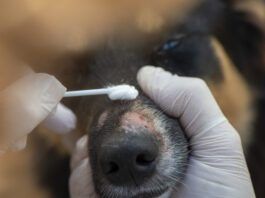Can Dogs Catch a Cold?
Dog owners nationwide are concerned about a severe canine respiratory virus that doesn’t respond to traditional medications and is killing some dogs.
Getting a Dog Fecal Sample for Internal Parasite Testing
A dog fecal sample for internal parasite testing is critical to determining effective treatment for your dog. Stool samples can also provide other vital information about your dog's health.
Why Do Dogs Smell Like Fritos?
If your dog’s feet have a slight eau de corn chip, don’t worry. This smell is just from the normal bacteria that end up on dog feet throughout daily life.
Dog Elbow Hygromas
A hygroma is a large, fluid-filled lump on a dog’s elbow, or a fluid-filled lump on any bony point on your dog that frequently comes into contact with the ground when he sits or lays down. Elbow hygromas are the most common.
Can Dogs Get Sunburn?
Dogs can get sunburn despite their fur. This is not only uncomfortable for the dog, but can increase their risk of skin cancer the same as it does in humans. Plan to provide sun protection for your pooch during outdoor activities.
Do They Make Hearing Aids for Dogs?
Hearing aids for dogs are very expensive. custom fit, and require frequent visits to check both fit and settings. Dog vibration collars provide a more affordable and effective way for owners to communicate with their dogs.
Why Is My Dog’s Nose Wet?
A wet nose strengthens your dog’s sense of smell, which is one of his most amazing senses. In a few instances, however, a wet nose can indicate something is amiss.
Can I Give My Dog COVID?
Research on canine-to-human and canine-to-canine transmission of COVID strains is inconclusive and data is frequently conflicting. Dog and other pet owners should be cautious and look for signs of COVID infection in their pets, and limit contact if they themselves test positive.
Histiocytomas in dogs
Histiocytomas are skin tumors that are raised and hairless and may be flesh-colored, pink, or red. They often look like a small button on the skin.
These benign tumors that are most commonly found in dogs less than 6 years old.
Signs of Pancreatitis in Dogs
Any time you see “-itis” at the tail end of a word, it means inflammation of whatever it comes after. Dermatitis is inflammation of the skin. Enteritis is inflammation of the intestines. Hepatitis is inflammation of the liver. Pancreatitis is inflammation of the pancreas.
Coccidioidomycosis: A Southwestern Hazard
If you live in or travel to the Southwest, particularly Texas, California, or Arizona, it is important that you know about a fungal infection...
What is Myasthenia Gravis in Dogs?
Myasthenia gravis in dogs is a relatively rare neuromuscular disease in which there is a breakdown in the transmission of signals between nerves and...


















